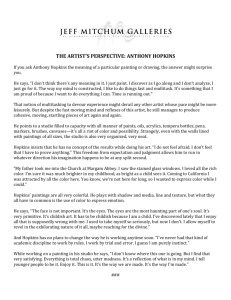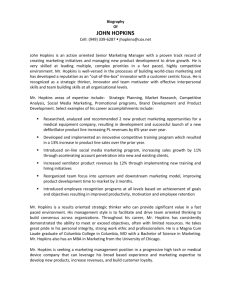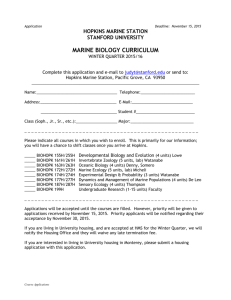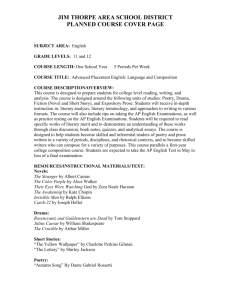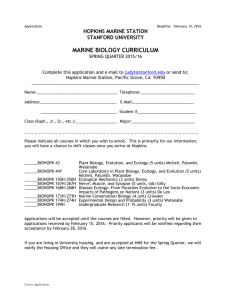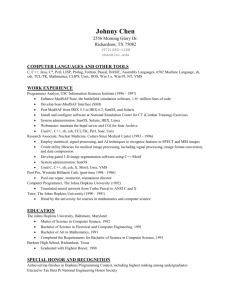Click here for a Printable Version
advertisement
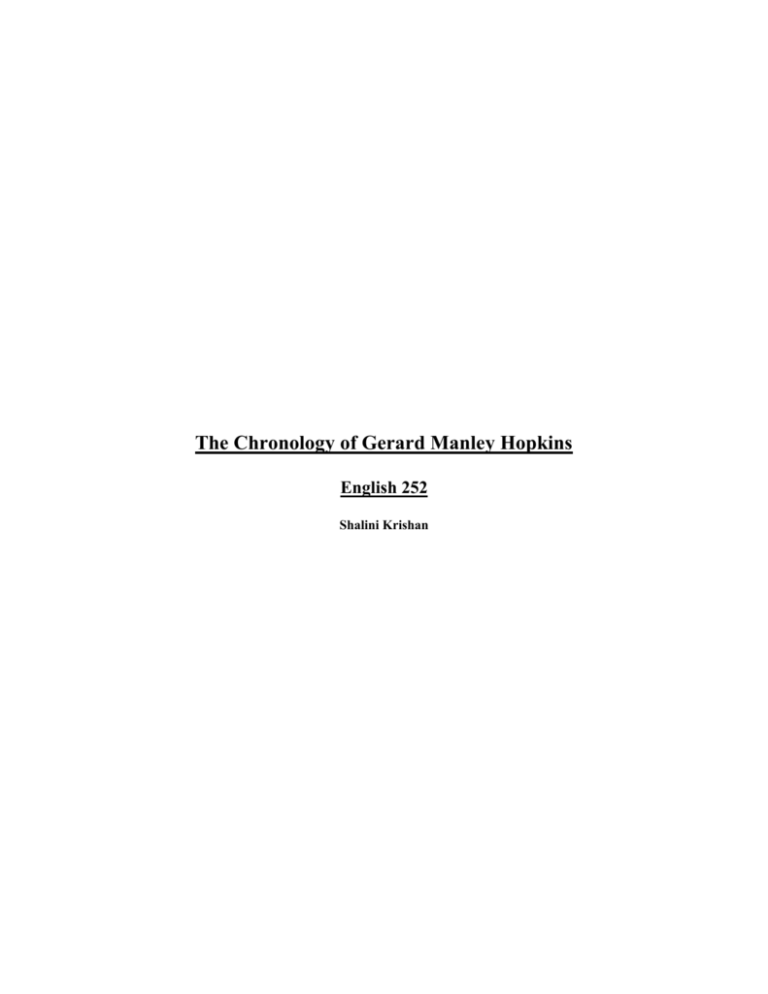
The Chronology of Gerard Manley Hopkins English 252 Shalini Krishan 1 Gerard Manley Hopkins is an important poet whose works are peculiarly hard to identify chronologically. Although he lived in the Victorian era, he is often regarded as a pioneer of the Modernist school of literature, because of the originality of his poetic style and structure. Incongruously, many of the themes and underlying feelings of this strange new poetry echo the familiar Romantic poets who famously celebrated nature and the self. This essay attempts to reconcile the dichotomy between Hopkins’ technique and theme, and thus come to a conclusion about his place in the chronology of English literature. The original classification of Hopkins in the Modern school of literature was due to two main factors. Most importantly, his poetry remained unpublished “until twentynine years after his death” in 1918. (Abrams et al.1648). As he was then a new discovery, who did not follow the pattern of Victorian writing as exemplified by Tennyson and Swineburn etc, he easily fitted into the canon of modern writers of that era as a visionary poet ahead of his time. In addition, “Victorianism” was out of fashion during the 1920s and no longer thought to be of critical worth so Hopkins was seen as “miraculously unconnected” with his temporal habitat. (Abrams et al. 1648.) “Smug or prudish or imperialistic or hypocritical or over-optimistic,” were all impressions of the Victorian era in the Edwardian mind. (Johnson, 6.) In reality though, it is much harder to define and many of these are the stereotypes of a society that was undergoing a reaction to the morals and ideals of the Victorian era. 2 Hopkins’ own particular style of writing lent itself to this interpretation. He did not imitate the heavy-handed Tennyson’s long epics, which are stately and full of “dignified blank verse” and seem to embody the stereotyped idea of an overly formal and stratified Victorian society. (Abrams et al. 1199). Tennyson’s poems in general follow a very settled metre that emphasises the tone of his poem; for example, in “Mariana” he uses a repetitive rhythm to further give the impression of a dull monotonous place: All day within the dreamy house The doors upon their hinges creaked: The blue fly sung in the pane; the mouse Behind the mouldering wainscot shrieked ….………………………………………. She only said, “My life is dreary, He cometh not,” she said; She said, “ I am aweary, aweary, I would that I were dead!” (Tennyson, 61-64, 69-72.) By describing the usual petty events in the house such as a squeaking mouse in a measured and overly rhythmic style he imparts a slothful and decaying ambience to the whole poem. The ending of each verse is almost the same and the use of two rhyming words that are reiterated gives a sense of hopelessness and lethargy. Even the death wish 3 of Mariana doesn’t excite or alarm the reader; it is a part of the general decline of the whole poem. In contrast, poems such as “Pied Beauty” by Hopkins seem to disdain the ponderous rhythm in poems such as “Mariana” and instead deliberately create a light and skipping effect by joining words and phrases together unusually: For skies of couple-colour as a brinded cow; For rose moles all in stipple upon trout that swim Fresh-firecoal chestnut-falls, finches’ wings; Landscape plotted and pieced – fold, fallow and plough; (Hopkins, “Pied Beauty” 2-5 1653). The combined effect of alliteration and hyphenation of words in the phrase “Freshfirecoal chestnut falls” makes the general idea of burnished, glossy chestnuts, falling in a sunny blaze of autumnal colours into a single mental picture, like a snapshot taken on a bright fall day. (Hopkins, “Pied Beauty” 4). The whole verse flows together even though the individual images are sharply different. One of the novel techniques that Hopkins uses to produce his effect of a shining poetic image is alliteration. For example, in “The Windhover,” the stresses in each word are caught in the next word to re-emphasise the sounds and continue the flow of the poem in a series of stop and go rushes that multiply the effect of the image. For example, in is echoed again and again: I caught this morning morning’s minion, kingwhile the next line emphasises the dau sounds; 4 dom of daylight’s dauphin, dapple-dawn-drawn Falcon and the sounds in Falcon are an echo of caught and bring the two lines together in a cycle. (Hopkins, “The Windhover,” 1-2. Emphasis mine; Hartman, 49). Unlike traditional Victorian poets, Hopkins uses repetition and juxtaposition of words to very evidently build images that are used to crystallise a thought or idea. For example, in “Pied Beauty” the reader has a series of brilliant illustrations that are not presented wholly, but are allowed to slowly emerge in their mind. The unifying theme of “dappled things” and the direction of the poem emerges only when the images flow into each other by echoes of alliteration. There is no statement of intent at the beginning of the poem that prepares the reader for the ending of “Praise him.” (Hopkins, “Pied Beauty,” 1, 11, 1653). This is again in contrast to Tennyson and other Victorian poets who when they bring an image into sharp relief either do it for a specific reason, to act as a symbol or merely as part of series that gives background and further heightens the main focus of the picture. For example, in “The Lady of Shallot” the lines: Sometimes a troop of damsels glad, An abbot on an ambling pad, Sometimes a curly shepherd lad, Or long-haired page in crimson clad Goes by to towered Camelot. (Tennyson, 55-59) show a series of images that are sketched lightly, so that there is one important detail about each figure such as the slow horse of the abbot or the “long-haired page in 5 crimson” that brings it into focus and at the same time shows the contrast between the busy road and the lady’s vacant life. However, the images do not display their inscapes, they are clearly poetic devices and not of any intrinsic value in the poem. The Romantics such as Wordsworth often tended to focus on one image and describe it, like Hopkins, but without the all-pervading sense of religious joy that is characteristic of Hopkins’ poetry. Unlike the Victorian era’s discomfort with nature, the Romantics embraced it because they could use it as a mirror to the self. Wordsworth, in particular uses “Lines composed a few miles above Tintern Abbey, on revisiting the banks of the Wye during a tour” (abbreviated to Tintern Abbey) to describe his own development in since the last time he saw this scene of nature. There is a sense of the sublime in his descriptions of images, which in contrast are individually matter of fact. For example these descriptions from “Tintern Abbey:” Once again I see These hedge-rows, hardly hedge-rows, little lines Of sportive wood run wile: these pastoral farms, Green to the very door; and wreaths of smoke Sent up in silence, from among the trees! (Wordsworth, 15-18) are of a very normal countryside scene that isn’t remarkable in any way. Wordsworth’s feelings for the countryside are however strong enough that they prompt him to examine himself and his development over the 5 years. Hopkins’ strong feelings upon viewing a falcon prompt him to more than just description or introspection. He is remarkable for 6 his innovations in style that allow him to express the same joy that the Romantics felt upon viewing Nature but also express his ideas of religion through a mixture of new techniques and inspired vocabulary. Hopkins had extremely innovative ideas and methods of writing poetry for the Victorian era, which contributed in part to his reluctance to publish his works. When they were finally published they influenced many of the modern poets such as W.H. Auden and so Hopkins was associated with a modern style that actually was somewhat based on his methodic innovations. It has already been pointed out that all the different motions and images involved in the poem “Pied Beauty” are actually one being together, as they are juxtaposed to form one image of startling clarity. Hopkins felt that poetry could show the intrinsic being of any object or organism. This idea was imbued with a theological significance by Hopkins who said that it was the inscape, or the idea that everything has a “pitch of self,” an ultimate identity. (Hartman, 57.) He expresses this idea as: Each mortal thing does one thing and the same: Deals out that being indoors each one dwells Selves- goes itself: myself it speaks and spells; (Hopkins, “As Kingfishers Catch Fire,” 5-8, 1652). His theory is that each organisms’ inscape is characteristic and cannot be compared to any other’s and that in this multiplicity of inscapes that of the humans’ is the highest. 7 The inscape of every organism is the presence of the divine in it, according to Hopkins the instress but in humans the divine is the presence of Christ himself, so their sense of identity is the strongest. This is one of the many contradictions in the themes of Hopkins’ poetry. While a dogmatic sense of religion and belief in a divinely ordered structure is not a solely Victorian outlook, it is associated with the Victorian era. In particular, the middle Victorian period from 1850 to 1870 prided itself on having a sense of moral earnestness that it expressed through religious practices such as sending missionaries, and upholding “decent” values in society. The more modern writers of the Aesthetes and Decadents, such as Oscar Wilde mocked these Victorian ideals and satirically imitated them in The Importance of Being Earnest when Algernon says: “Really, if the lower orders don’t set us a good example what on earth is the use of them? They seem, as a class to have absolutely no sense of moral responsibility.” (Wilde, Act 1.) It’s clear that Hopkins did not fit into this image of the self-satisfied, earnestly moral Victorian. He does not seem to advocate in his poetry, at least, the preaching aspect of religion, even though he himself was a Roman Catholic priest in a more traditional and conservative religion. The Victorians are also noted for their constant ambivalence towards the existing cultural mores such as “the necessity of work, the importance of both cultural order and individual freedom, the place of woman in society, “ etc. (Johnson, 8.) In many of their works such as Carlyle’s “Sartor Restorus” there is ambivalence between the author and his works. It’s hard to determine to what extent Carlyle identifies himself with the philosophy of Diogenes Teufelsdröckh, because of a deliberate effort on his part to 8 separate the writer from the work. However, Hopkins, is clearly in no doubt about the role of God and of religion in human life; his poems do not present an argument for the existence or benevolence of God, but are illustrations of the given idea which he does not feel necessary to question. In this respect it can be argued that Hopkins is very far from belonging in the Victorian era because he has a sure sense of identity, both individual and of humanity as a whole in the general world. Victorian writers such as Carlyle and John Stuart Mill for the first time addressed the question of self-consciousness. (Johnson, 20.) They, and many Victorians were painfully aware of themselves and uncertain of their place in the world; the established order, though still extant was crumbling and many people were no longer sure of their standing and were losing faith in the idea of a divinely ordered system. Victorians such as Carlyle had an emphatic belief in a new system that was not the “Hebrew old clothes” of the traditional Church and that he expressed in his philosophy of Fire-baptism. (Abrams et al. 1068.) Hopkins however, was “self-conscious” in the Romantic sense of the word – “fascination with one’s self.” (Johnson, 20.) Like Wordsworth and Keats he was aware of the effect of his own mind and strove against it. In “Carrion Comfort,” he realises that he is wrestling with his own mind about the issue of despair, in the same way as Keats struggled with melancholy. Keats’ sonnets were melancholy not because the situation of a singing nightingale or a Grecian urn is intrinsically sad, but because he throws the shadow of his own “all-pervading melancholy” onto the objects around him. The lines express this in one of Hopkins’ earlier poems “The Nightingale:” 9 With not a thing to make me fear A singing bird… To me was terrible to hear. (Hopkins, as quoted in Johnson, 77.) This realisation and fascination with the mind’s power was self-consciousness to the Romantics and Hopkins echoes it. Nevertheless, he is sure enough of his own ideas of the universal position of organisms in relation to each other and to God to identify his own self as Christ: “I wretch lay wrestling with (my God!) my God.” (Hopkins, “Carrion Comfort,” 14, 1656.) The Victorian writers however were nervously exploring the idea of a writers personality unconsciously being expressed in their writings and many such as Tennyson tried to disguise their presence in their works (ref. “The Kraken,” below.) This refusal to fit the conventions of Romantic poetry and thought, yet at the same time not be trammelled by the problems of the Victorian era is present in Hopkins’ attitude to the world of nature. Many of his poems such as “Pied Beauty”, “Spring and Fall”, “Binsey Poplars” and “Hurrahing in Harvest” praise the natural world with the same love and sense of harmony as the Romantic poems like “The Daffodils” by Wordsworth. Yet, they are neither simple descriptions of an object as the Romantics would often write, nor are they a complicated allegory or just there to set the scene for an epic. Hopkins draws some significance from his images of natural objects; for example, “The Windhover” can be taken to represent Christ and the Crucifixion, but the style and 10 tone of the poems is very different form the allegorical tone of many Victorian poems such as “In Memoriam.” In addition his poetry is not characterised by a “tense, problematic” relationship between himself and his environment, that the Victorians expressed through distrust of nature. (Johnson, 9.) For example, while Tennyson typically uses his poetry as a tool to transform the images by making them form the tone of the poem, Hopkins tends to focus on the image itself and describe it perfectly. In “The Kraken” Tennyson never physically describes the giant octopus, but instead gives a general idea of its supernatural and monstrous nature by using words such as “ancient, dreamless, uninvaded sleep” and by the general description of the “sickly” “slumbering green” surrounding it. (Tennyson, 3, 7, 10.) This view of a non-idealised nature that is not a sublime method of expressing the self is a Victorian idea, and seems to point the contrast between Hopkins celebration of God in the flesh and the general Victorian discomfort when dealing with things of the flesh. In addition to the puritanical uneasiness with sensual imagery that Victorians had with the poetry of the Romantics, they also had trouble adjusting to the new ideas of evolution and the place of humans in the world as another type of animal. The society was faced with the idea that there was no divine provision for humans to be superior to other animals and so the previous self-confident images of nature, whether violent or peaceful forced them into introspection about the place of humans in world. Hopkins seems to avoid this in his poetry due to his theological belief in inscape that allowed him to see the divine in all organisms and retain a clear-eyed joy in natural imagery. His 11 poetry though does not copy the Romantic theme of “thankfulness to Nature which… never betrays…the heart that loves her,” he instead looks at Nature and finds evidence of his own joy in God and religion. (Hartman, 3). To conclude, therefore, Hopkins’ place in the confusing range between Romanticism, Victorianism and a more modern era is like that of the Maidenhair fern tree in biology.1 He acts as a link between the three eras by using elements of both the Victorian and Romantic themes and techniques, but creates his own distinctive style that is used in the evolution to the modern, 20th century style of poetry. The maidenhair fern tree, Ginkgo biloba is the “missing link” between the coniferous gymnosperms and the deciduous angiosperms, as well as being one of the first types of plants after ferns. Unlike either conifers or deciduous trees, individual trees may or may not shed their very characteristic leaves, but if they do, they lose all their leaves within a few days. It is a “living fossil” of the evolution of modern day gymnosperms. 1 12 Works Cited Abrams et al. “Alfred, Lord Tennyson. 1809-1892.” The Norton Anthology of English Literature, Vol. 2. Seventh Edition. New York, London. W. W. Norton & Company Inc. 2000. Pg.1198-1201. Abrams et al. “Thomas Carlyle. 1795- 1881” The Norton Anthology of English Literature, Vol. 2. Seventh Edition. New York, London. W. W. Norton & Company Inc. 2000. Pg.1066-1069. Abrams et al. “Gerard Manley Hopkins. 1844-1889.” The Norton Anthology of English Literature, Vol. 2. Seventh Edition. New York, London. W. W. Norton & Company Inc. 2000. Pg.1648-1651. Bergonzi, Bernard. Gerard Manley Hopkins. Masters of World Literature Series. L Kronenberger, gen. ed. Collier Books. New York. 1977. Hartman, Geoffrey H. The Mediated Vision: an Interpretation of Wordsworth, Hopkins, Rilke and Valery. Yale University Press. New Haven. Oxford University Press. London. 1954. Hopkins, Gerard Manley. The Norton Anthology of English Literature, Vol. 2. Seventh Edition. M. H. Abrams et al, eds. New York, London. W. W. Norton & Company Inc. 2000. 1651-1661 Johnson, Wendell Stacy. Gerard Manley Hopkins: The Poet as Victorian. Cornell University Press. Ithaca, New York. 1968. 13 Tennyson, Alfred, Lord. The Norton Anthology of English Literature, Vol. 2. Seventh Edition. M. H. Abrams et al, eds. New York, London. W. W. Norton & Company Inc. 2000. 1208-1304. Wilde, Oscar. The Importance of Being Earnest The Norton Anthology of English Literature, Vol. 2. Seventh Edition. M. H. Abrams et al, eds. New York, London. W. W. Norton & Company Inc. 2000. 1762-1805. Wordsworth, William. The Norton Anthology of English Literature, Vol. 2. Seventh Edition. M. H. Abrams et al, eds. New York, London. W. W. Norton & Company Inc. 2000. 222-383.

